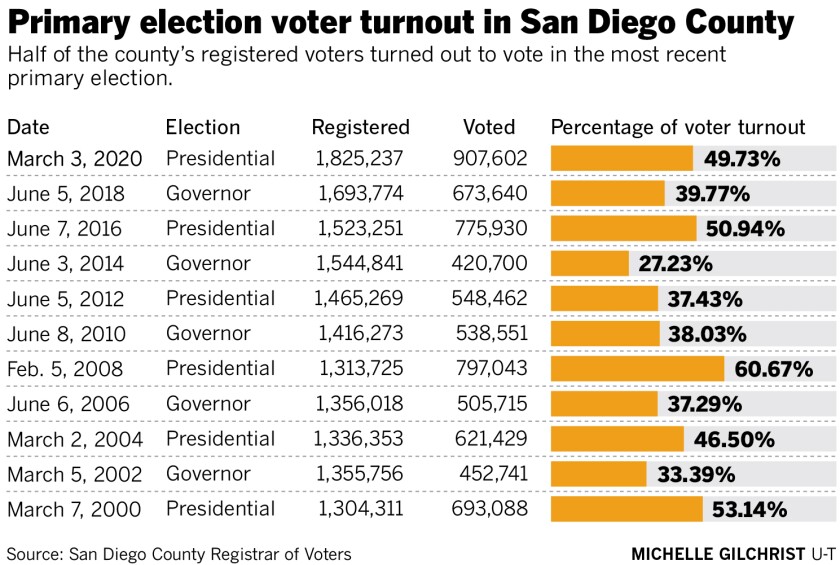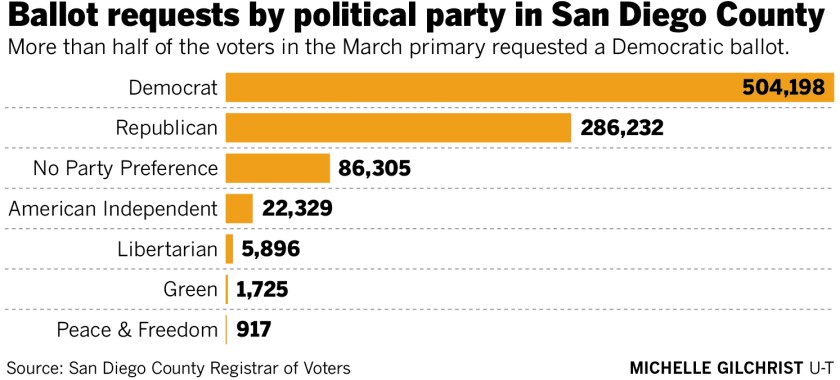The March primary did not deliver the spike in voter turnout that some anticipated, even though more San Diegans cast a ballot than in any primary before.
According to data from the Registrar of Voters Office, 907,602 San Diego County voters cast ballots in March.
That beats the ballot total during the 2016 presidential primary by more than 131,600 votes and the 2008 primary by more than 110,000, when turnout hit 61 percent, the highest in two decades.
This year’s turnout was 49.7 percent, a drop from the 59.4 percent turnout in 2016.
Advertisement
Of the 907,602 votes cast, 72 percent came in the mail and 28 percent were cast in person at the polls.
The registrar reported 56 percent of voters asked for Democratic ballots and 32 percent requested Republican ballots. The Democratic ballot was open to nonpartisan registered voters.
Nevertheless, other voters opted for independent, Libertarian, Green Party or other party ballots or they asked for no-party-preference ballots.

Michael Vu, San Diego County registrar of voters, said he expected a more robust turnout in March, given the high political energy displayed during the 2018 general election, which was the most active midterm election since 1982 with a 66.4 percent voter turnout.
Advertisement
He said a 49.7 percent turnout for a primary is “healthy” and the increase in the number of people voting was impressive.
“It’s fascinating to see that, as large of a county as San Diego County is, it still produces huge numbers like it was a smaller jurisdiction, where you generally see higher turnouts,” Vu said.
“At the end of the day, it just shows you the breadth of civic mindedness San Diegans have in voting.”
Thad Kousser, chair of the political science department at the University of California San Diego, said it is not surprising that turnout is flat, despite high interest in the presidential race, because the push to get more Californians registered to vote has been successful.
Advertisement
California’s motor voter law since 2018 has automatically registered people to vote when they get a driver’s license, unless they opt out. It dramatically increased the number of people registered to vote.

In San Diego County voter registration grew 20 percent since the last presidential primary, climbing from 1.52 million registered voters in June 2016 to more than 1.82 million in March 2020.
“Both our registered electorate and total votes have grown, but because they have been growing together that percentage hasn’t risen,” Kousser said. “But it still means more and more San Diegans are participating.”
Advertisement
The overall rise in voter participation in March played out differently in different parts of the county.
In San Diego’s five congressional contests — two of which involved rare open seats— turnout varied widely.
The San Diego County congressional district that saw the highest turnout was the battleground 49th District, which stretches from northern La Jolla to Dana Point and includes Vista and Camp Pendleton. The 49th featured incumbent Democratic Rep. Mike Levin and Republican San Juan Capistrano City Councilman Brian Maryott. Nearly 55 percent of voters in the San Diego portion of the district turned out to vote.
Following closely behind, registered voters in the 52nd District — which consists mostly of coastal and central San Diego — turned out at more than 54 percent. Unlike the 49th District, the race for the 52nd — featuring four-term incumbent Rep. Scott Peters and Republican businessman Jim DeBello — is not expected to be competitive in November.
Advertisement
In contrast, turnout in the 51st District — which stretches from San Diego Bay to the California-Arizona border and includes some southern portions of San Diego and all of Imperial County — was only 34 percent. The district is overwhelmingly Democratic and features incumbent Rep. Juan Vargas, D-San Diego, who has never faced a serious challenge.
Meanwhile turnout in the race for San Diego County’s two open congressional seats, the 50th and 53rd districts, was fairly similar.
In the traditionally Republican 50th District — where candidates sought to replace disgraced former Rep. Duncan D. Hunter to represent East County, inland North County and part of Riverside County — voter turnout was nearly 52 percent.
In the heavily Democratic 53rd District, where candidates fought to succeed retiring Rep. Susan Davis, D-San Diego, turnout was nearly 49 percent.
Advertisement
And across the city of San Diego, which featured a citywide ballot measure and a high profile mayoral race, turnout was nearly 50 percent.
Kousser said the variations in turnout were not so much about campaigns specifically or whether a race was competitive. It was more about demographics, he said, noting that areas with affluent, older voting populations that are not diverse tend to turn out at higher rates.
He said campaigns are less likely to reach out to voters in areas where there is low turnout, creating a “viscous cycle” where some potential voters don’t cast ballots because they feel ignored.
“Hot campaigns drive turnout differences at the margin,” Kousser said, “but these large differences that persist, election after election, are generally due to demographic and structural explanations.”
Advertisement
Demographic differences were clearly displayed in the races involving the South Bay and the more affluent northern parts of San Diego County.
The congressional and county supervisor races that featured northern and coastal San Diego — the 49th and 52nd congressional districts and supervisor District 3 — had some of the highest turnout in the region; all eclipsed 54 percent.
Meanwhile the races for the 51st Congressional District and District 1 county supervisor, which heavily involve the South Bay, saw the lowest turnout rates in the region, both less than 38 percent.
“As much ink as is spilled by the local press — to good effect — about the 50th, it isn’t the biggest concern of voters,” Kousser said.
Advertisement
“People are still thinking of Donald Trump and the Democratic nominees much more than they are (about) members of Congress. You see in election after election, it is presidents who have coattails, not members of Congress.”
The healthy turnout, jump in ballots cast, high interest in the presidential race and the region’s high percentage of mail ballot voters has election officials and political observers expecting voter engagement will remain high come November.
What’s unknown is how the spread of COVID-19 may impact turnout.
Vu said the fact that voters cast ballots in such high numbers despite having to take extra steps to ensure they got the ballot of their choice shows San Diegans were determined to get out and vote.
Advertisement
"though" - Google News
April 27, 2020 at 07:02PM
https://ift.tt/3bIsdVO
900,000 San Diegans voted in March, highest for any primary before, though turnout rate stayed flat - The San Diego Union-Tribune
"though" - Google News
https://ift.tt/2FnFft4
Shoes Man Tutorial
Pos News Update
Meme Update
Korean Entertainment News
Japan News Update
Bagikan Berita Ini

















0 Response to "900,000 San Diegans voted in March, highest for any primary before, though turnout rate stayed flat - The San Diego Union-Tribune"
Post a Comment